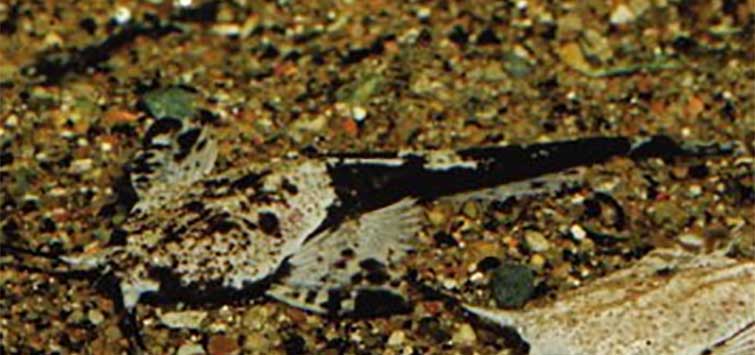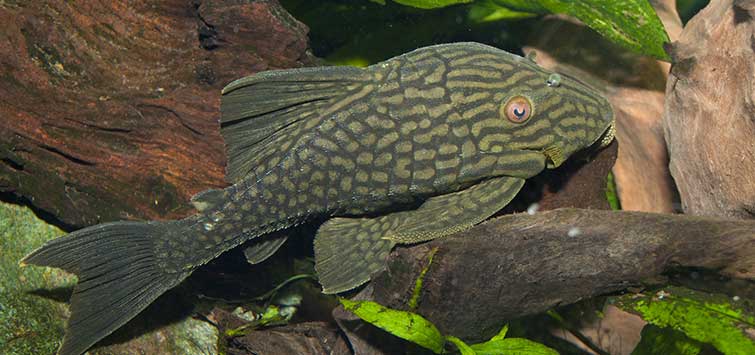Catfish Corner: Foods, Feeding Banjos, and Ted
Author: Lee Finley
Catfish Corner: November 2007
The proper feeding of our fishes is an important part of their successful captive management, and I would like to make some comments regarding this topic on a particular group of catfishes. I will briefly discuss what the catfish eat in their natural habitat, and then look at how we might provide a similar diet in captivity.
Commercial Food Recall
First an upfront note needs to be made. As part of what follows, the use of a variety of commercially prepared fish foods will be suggested for use. In that a small number of such products became involved in the recent melamine-tainted pet foods fiasco, some care might need to be exercised. A quick Internet search showed that at least two companies producing fish food had voluntarily recalled certain products. One of the companies listed a total of 19 such foods. Even if it were not against this magazine’s policy to mention brand names within editorial copy, I prefer to not name the companies involved; hopefully, since they are actively working to fix the problem, by the time that this is published this problem will be straightened out and the companies will once again have their untainted products available.
Nevertheless, caveat emptor. Such foods, as those mentioned above, may yet remain for sale somewhere (or exist as part of the freebies that aquarium societies receive from manufacturers). Whether melamine, at the detected levels, is potentially harmful to tropical fishes is unknown. But, on general principle, it would no doubt be best to avoid it where possible.
With that consumer alert out of the way, let’s move on to the next topic.
Feeding Banjos
It is not exactly a big secret that most of the common aquarium catfishes can get by quite nicely, thank you, on a varied diet of standard commercial foods (flakes, tablets, pellets, etc.). Unquestionably, such foods should be part of the dietary profile that you develop for your catfishes, but it is ideal to expand out and provide other foods for them. These can include a wide variety of “meaty” and vegetable-based food items depending on the fish under consideration. These need to be chosen with the natural diet of the fish in mind. Granted, this may not always be easy to figure out, in that the necessary studies from which to extract this information may be few and far between. But one may extrapolate a bit from what is available and take it from there. We just need to try to keep learning and do the best that we can.
With the above in place I would like to say a few words on the feeding of banjo cats. These are South American in origin and belong to the family Aspredinidae. This is a relatively small family and currently consists of 36 species divided among 12 genera (both undescribed genera and species are also known). Most of the banjos that we see in the hobby are fairly small catfishes that range in size from 3 to 4 inches, and most of them that are imported are members of the genus Bunocephalus, although other genera (e.g., Pterobunocephalus) may be encountered from time to time.
Social Characteristics and Feeding
Banjos tend to be shy and retiring (especially early on in their aquarium life), and once they are in the tank their presence is often hard to detect. They will seek out hiding places, and if the substrate is of a small size (more sand-like) they will often burrow and bury themselves therein. Consequently, banjos are not necessarily a good choice for a tank with a lot of active and fast-feeding fishes. In such a case there will often be little or no food left for them when they do come out to feed, which is most often after lights-out. Granted, some banjos may adjust more quickly and eat at regular feeding times, but this cannot be assured. So it is ideal to maintain these fishes in a “quiet” type tank with such fishes as small tetras, dwarf Corydoras, etc. And even with this, it is best (as with many catfishes) to put some food in the tank about a half hour or so after the lights have been turned off. You also want to make sure that the food sinks to the bottom, as banjos are not prone to coming to upper water levels to feed. If you are using some flake food, be sure and stir it up in the tank so that it sinks.
Natural Diet
What work has been done on the natural diet of Bunocephalus spp. (and closely related forms) shows them to feed on a variety of macroinvertebrates and detritus. The invertebrates recorded in their diet include various insect larvae and nymphs, small worms, some adult aquatic insects, and various adult terrestrial insects. Due to the relative small mouths of these fish, it does appear that a good part of their prey (insect larvae and worms) tends to be thinner and more elongate, which facilitates ease of ingestion. The ingestion of terrestrial insects (land, plant, and/or flying) would be as a result of their falling into the water. Some fishes, including many catfishes, will actively feed on these at the surface. But in the case of banjos, it is more likely that they would feed on such foods after they have sunk to the bottom. Detritus is defined as broken-down plant matter, and many fishes use this as a good food source. In addition to what direct nutrition it provides, it is often rich in a wide variety of microorganisms that further bolster the nutritional value. Some direct plant matter has also been reported as a food source in some specimens. This consisted of debris, leaves and flowers, and fruits and seeds. The amount of this material was comparatively small (slightly over 10 percent of the diet).
Recommended Diet
So, to feed banjos, it would be good to start by using a good, rotating variety of prepared commercial foods. I would recommend the keeping on hand and use of at least three such items. Flakes are a good source of nutrition, and ideally you should regularly use at least one that has a higher vegetal-based content. This is usually accomplished by the inclusion of Spirulina algae, but some formulas also add additional items (spinach, alfalfa, wheat germ, etc.) that are desirable. Be sure and read the various labels and choose a food with the best variety of such sources. Marine flakes are often rich in additional vegetal-based material and are perfectly fine to feed to freshwater fishes as part of a rotating diet. A good “basic” flake should also be used. Finally, these can be rounded off with a more meaty-based flake such as one based on brine shrimp, tubifex worms, etc. Following these general principles you can also use various pellet style foods. But in the case of banjos just make sure that, first, they are of a sinking type, and second, that they are of a generally smaller pellet size.
The use of straight meaty foods is also highly recommended. This can include frozen and/or freeze-dried foods. I tend to prefer the frozen forms for their ease of use. Bloodworms, which are chironomid (midge) larvae and one of the preferred natural foods of banjos, are a good example of this. With the frozen form they need only be defrosted in a container of cold water, rinsed under running cold tap water, and then fed. They readily sink and will be available to any bottom fishes like banjos. With the freeze-dried form they can be soaked in the same manner, but usually a majority of them will end up floating. Overall, this is not bad, but is only good for fishes that will come to the top to feed, which rules out your banjos. In addition to bloodworms you can choose other such foods. Brine shrimp is a good staple (but don’t overfeed with it) and other choices such as plankton (small shrimp), Daphnia, etc. should also be considered. There are also some insect foods aimed primarily to the captive reptile market that are worthy of consideration for use. [For more about banjo catfish, see “The Banjo Cats,” p. 90—Eds.]
Ted’s Column
I recently read with interest my friend Ted Coletti’s September, 2007 “Livebearers Unlimited” column entry in this magazine (“The Emperor Wears No Clothes: Endler’s Livebearer is Still a Guppy”). What, Ted was writing something on catfishes? Not at all; I will be the first to admit that my interests go far and beyond catfishes (ask me about my antlion, a.k.a doodlebug, colony sometime).
Ted’s column was aimed at the taxonomic situation surrounding the so-called Endler’s livebearer, a beautiful and popular fish. The skinny on Ted’s information is that while this fish was described as a new species (in 2005), there have been many parties (Ted included) who have consistently maintained that it is just a “real nice guppy.” Ted goes on to discuss the results of a study on this fish that were presented at the last American Livebearer Association convention in early 2007. The conclusion of this work was that the Endler’s is in fact “just” a guppy, albeit a nice one.
The situation that Ted gives good coverage to is but one among numerous similar cases. The science of taxonomy, although governed by a fairly complex set of rules, is fluid and open to the not so governable concept of opinion. There are numerous situations in the field of ichthyology similar to that mentioned by Ted—not only just with livebearers or catfishes, but in just about any group that you can think of. But this is the natural flow of things, and in the end we can all benefit—and even be entertained by it. While there may be little to no hobby interest in some never-to-be-kept species, fish like Endler’s do capture the attention of a wide hobby audience. The same can be said regarding the current ongoing situation with discus. I am sure that Wayne Leibel will have more on that issue shortly.
There are many similar parallels with catfishes. An example that quickly comes to mind, though somewhat different, is with the Callichthyidae genus Scleromystax. Everyone it appears agrees that this genus, which for a long time was considered as a synonym of Corydoras, is valid. Hobby-wise the most recognizable species in the genus is S. barbatus. It has long been recognized in the hobby that there are some “different” S. barbatus. At least one of these, according to some parties, nicely fits within the name S. kronei, a catfish described in 1907. Those who believe that this is a different species use this name. But others consider these fish as nothing more than a variation and place it in synonymy with S. barbatus.
This is, no doubt, also to be continued.
See the full article on TFH Digital http://www.tfhdigital.com/tfh/200711/#pg54

.png?h=595&iar=0&w=2781&hash=5FD5E69473BCC22199FBFA2FB71B6033)



